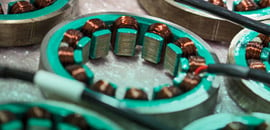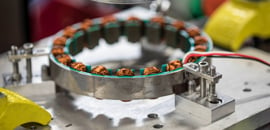Overview
The permanent magnet brushless motor, also know as; brushless DC, brushless AC, brushless servo, and synchronous motor, can be driven by two control configurations. Hitorically, motor controllers used DC square waves of current switched in six different states based on signals from hall devices spaced at 120 electrical degrees, (the six state drive). Today, most brushless motors of this type are driven by motor controllers using sinusoidal current control with space vector modulation.
Sinusoidal current control offers the most advantages in smooth motion from a smoothly rotating torque vector. Running a synchronous motor with sine wave is natural and effective because the motor generates torque proportional to angle sinusoidally. In this configuratio, all three phases of the motor are used at all times and the optimum commutation angle set for maximum torque production at all times making torque proportional to current.
The challenge with selecting a motor and predicting performance using sinusoidal control comes in relating published motor data sheet parameters to actual motor operation.
This technical paper explores the theory behind motor and drive interaction and more specifically provides focus on parameter conversions and torque production.
Please refer to TN-2001 for examples of motor torque production, i.e. the torque verses angle curve. Also refer to TN-2002 for more details on matching motor inductance between the motor controller and the motor.
The 3 Phase Brushless PM Motor
Most brushless motors, whether linear or rotary, have three electrical phases. It is common practive to connect the center tap of each phase together inside the motor, in a “wye” configuration, then bring out three power leads.
Fugure 1 – A resistor network representing a “wye” configuration. This represents three power input wires and the return of each phase connected together in acenter tap inside the motor.
Based on this industry standard wye configuration, the measured parameters of the motor tend to be line-line readings. This is actually measuring a two phase on condition. When you see a datasheet for a motor you will notice the following electrical parameters, (line to line values).
The Torque verses Angle Curve
In all electromagnetic synchronous rotary devices, torque is a function of both current applied to the winding and the position of the rotor w.r.t. the stator phase. Measurment of this typically yieds a torque versus angle curve. It is the true representation of a motor’s ability to create torque at any specific angle. It is also a map of how torque changes with angle and current, including the effects of phase balance, cogging torque, and saturation within the motor.
As a motor is driven by a sinusoidal motor controller, current it applied to all three phases of the motor in a sinusoidal pattern with angle. While this method approaches an ideal system, i.e. sinusoidal current and sinusoidal torque verses angle, it can also be impacted from items like cogging torque or a mismatch between the control sine waves and the motor’s torque angle characteristics.
Figure 2 – Torque verses Angle (single phase normalized)
Figure 2 shows a typical torque verses angle curve for a rotary motor. It is depicting only one of the three phases of the motor. Two levels of current have been selected to show how torque changes with current. Cogging torque at 5% of the rated torque value is shown. Notice how the cogging torque imacts the total torque by reshaping the total torque output, especially at lower current levels.
The torque angle curve is critical to the performance of the motor. From Figure 2 above it is clear that at current level 2, essentially 50% of the motor’s rated current, the cogging torque plays a role to reduce the torque output at the peak torque position. This adds to the non-linear attributes of the torque verses current curve eventually causing torque ripple when all three phases are considered. There is not a constant rotating flux or torque vector.
It also causes the torque versus angle curve to deviate from the back emf curve in shape and amplitude. Therfore, the torque constant being equal to the back emf constant is a first order approximation.
Torque Linearity
Many motors are designed to optimize torque and minimize weight. This can force the designer to make compromise in copper volume verses steel volume. Magnetic steel has high Ni content for reduced losses and high efficiency, but also saturates prematurely when flux density is high.
When current is increased in the motor winding it is not uncommon to find that steel someplace in the magnetic circuit saturates. It is common to find that even at their thermal rating, many motors exhibit 5% saturation. This saturation value gets worse as current is increased into the intermittent torque range of the motor.
Torque Linearity – 5% saturation at rated current
This is more evidence to debunk the theoretical notion that Kt = Ke in brushless permanent magnet motors. Every motor is different, a designer may have optimized Km and weight knowing that there would be saturation.
The Sinusoidal Current Control Drive
Applying sinusoidal current to all three motor phases with amplitude that is function of angle can produce a constantly rotating current or torque vector (sans the above sections limitation). The resulting motor torque being equal to the vector sum of the torques of all three phases.
The equations are as follows;
Tphase a = Kt phase a * sin Φ
Tphase b = Kt phase b * sin (Φ + 120)
Tphase c = Kt phase c * sin (Φ + 240)
Since the phases of the motor are also sinusoidal (sans issues with cogging torque and saturation), the phase torque constants are as follows, (Kt values are per phase, not line-line measured values);
Kt phase a = Kt a * sin Φ
Kt phase b = Kt b * sin Φ (Φ + 120)
Kt phase c = Kt c * sin Φ (Φ + 240)
Kt a, Kt b, and Kt c are the single phase torque constants. Note: when measured per above we are measuring a two phase on condition.
Assuming that the amplitude of phase a, b, and c are the same and the torque verses angle for each phase is sinusoidal, combining the input current wave forms and the motor torque wave forms provide the following;
Tphase a = Kt a * sin Φ * sin Φ
Tphase b = Kt b * sin (Φ+120) * sin (Φ+120)
Tphase c = Kt c * sin (Φ+240) * sin (Φ+240)
Combining these equations with substitutions from above we come to;
Tmotor = Kt *i [sin2 Φ + sin2 (Φ+120) + sin2 (Φ+240)]
Tmotor = Kt phase * i * 1.5
Where:
Kt = peak value of the per phase torque angle curve
i = peak value of the per phase current sinusoid (not the RMS value).
Important Notes:
1. Both torque angle curves and current input curves are assumed to be pure sinusoids
2. Assumes all three the sinusoids for both motor and controller have the same amplitude.
In real world cases torque ripple results from non-linear aspects of cogging torque, phase balance in the motor, and phase balance in the motor controller.
Kt and Ke Measured verses Actual for Sinusoidal Control
As stated above, the three phase permanent magnet brushless motor is normally connected in a “wye” connection where the center tap for each phase is internally connected. Only three wires are accessible external. All measurements are for a line-line or a two phase on condition.
All of the theory above assumes a per-phrase torque constant Kt and assumes that input current is supplied to the neutral (center tap) connection. In order to reconcile this with datasheet measured values, a conversion to single phase is required.
Kt = Ke in metric units for PM synchronous motors.
Kt line-line = 2 * Kt phase
Sqrt(3)*Ke phase = Ke line-line
Kt sine = Sqrt (3) * Ke line-line / 2
Kt sine = .866*Ke line-line
Where Kt sine uses the peak of the driving sinewave, not the RMS value. In most data sheets you will find both Kt and Kt sine values. They are both line to line values.
Motor Constant Km
A widely used figure of merit to compare motors and size motors is the motor constand Km. A motor’s Km is a measure of its ability to create torque as a function of how much heat is dissipated.
This figure of merit can also be used to measure a motors ability to generate torque under a voltage limited case. For example, in low voltage appplications, motor resistance becomes a limiting factor in attaining current, therefore, limiting the torque production. A motor with a high Km will allow more current into the winding for a given voltage, (assuming Kt is fixed in both motors). This is directly related to the amount of usable area for copper the motor has.
Km = Kt / SQRT(R), the units are in NM/watt1/2
When making this calculation, it is critical to understand the parameters. For example, Kt and R must both be line to line value for accuracy. If you use Kt sine you must use the proper R per phase.
Km = Kt2 is another method of this calculation. It is important to compare units when comparing motor Km value.
Conclusion
Modern servo motor controllers, (also called drivers), all use sinusoidal current control. This is the preferred method of driving a three phase brushless synchronous motor with sinusoidal torque versus angle curves. Six state control arrived early in the technology cycle shift from DC to Brushless DC motors when microcontrollers and DSP based controllers were not available. Today it is rare to find a six state motor controller in a prevision servo control application.
There are many factors to be considered in selecting a motor. Assuming smooth motion is desired, sinusoidal control is paramount. Other factors like cogging torque and torque linearity must also be considered. For example, slotless motors have excellent torque linearily and zero cogging. Their absolute torque output for their size is lower than a slotted motor, but it really depends on how the slotted motor is going to be utilized and will all of the extra torque be available.











